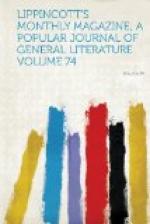One morning we went down in our wagons, drawn by horses belonging to members of our corps, and reported to the “International Society for the Aid of the Wounded.” We found them at the Palais d’Industrie. They did not think much of us, as we could not help perceiving, but they finally consented to let us go out at the first sortie—namely, that of Villejuif, when the French tried to take the villages of Thiais and L’Hay. We got upon the field just as the firing was over. The French had taken one village at the point of the bayonet, but at last they had retired so precipitately that they had left their wounded in the Prussian lines. There the poor fellows lay, in among the yellow wheat, with great well-fed Prussians prancing around them on horseback. It was a terrible scene, especially to me, being the first of the kind I had ever seen. But after a while I was so busy with the others, picking up the wounded and burying the dead, that somehow I lost my first overwhelming sense of the horror of the spectacle.
We smelt our first powder—that is, a few stray balls came among us—at Chatillon. Returning from this latter fight, we saw the burning of the palace of St. Cloud. It was a beautiful October sunset and evening, and the sight was indescribably grand.
You will, however, get a better idea of our share in a sortie if I tell you more particularly of the next one, that of Malmaison. It was there, in fact, that we began to make our reputation. This was the sortie fraught with most real danger to the Germans. They had not then had time to establish their lines, and if the attack had been followed up with more men, the French, it is thought, might have taken Versailles and cut the enemy’s line of communication. As it was, the Prussians had everything packed and horses saddled, ready to leave Versailles at a moment’s notice. Ur. Sarazin, chief surgeon of Ducrot’s corps, had asked us to rendezvous at the Rond Point de Courbevoie, just behind Mont Valerien, where the French had a battery. On our way out there that beautiful October afternoon, as we were driving up the hill from Porte Maillot, the American flag and the colors of the International ambulance flying over our five wagons, we were met by the whole provisional government of France.




